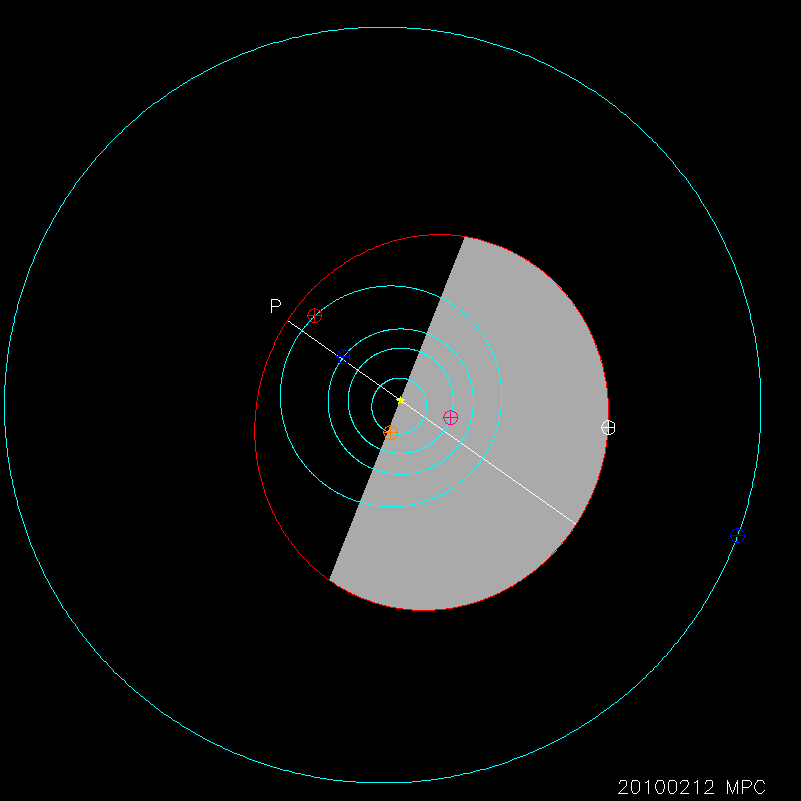(6354) Vangelis
Minor planet number 6354 has been named in honor of the Greek composer/multi-instrumentalist Vangelis.The citation announcing the naming appeared on Minor Planet Circular 25978 (issued on 1995 Nov. 7), from which the following is extracted with permission:
(6354) Vangelis = 1934 GA
Discovered 1934 Apr. 3 by E. Delporte at Uccle.
Named in honor of the Greek composer and multi-instrumentalist Vangelis
Papathanassiou. Vangelis began to compose and play the piano at age four.
At six, without any formal training, he gave the first public performance of
his own compositions, and soon developed the unique, spontaneous sound for
which he has become world renowned. In addition to numerous studio albums
and scores for theater and ballet, Vangelis has also composed numerous film
soundtracks, including 1492---Conquest of Paradise (1993),
The Bounty (1984), Bladerunner (1983) and Chariots of Fire
(1981), the last of which won him an Oscar for Best Original Score. Name
proposed by G. V. Williams, who made the identification involving this object.
Read about how minor planets are named.
About (6354) Vangelis
(6354) Vangelis is in a 4.34-year elliptical orbit around the sun ranging in distance from 311.8 million km (at perihelion, closest point to the sun) to 483.7 million km (at aphelion, furthest point from the sun).The next perihelion passage will occur on 2011 Nov. 1.2 UT.
The orbit is inclined by 24.5 degrees to the ecliptic plane (the plane of the earth's orbit about the sun).
There is little information on the physical properties of (6354) Vangelis. Even its diameter is uncertain--a range of 10 to 23 km is probable.
You will need a telescope to see this minor planet as its maximum brightness is some 1/1407 of the brightness of the faintest objects that can be seen with the unaided eye.
The diagram below show the orbit of (6354) Vangelis in relation to the major planets in the inner solar system.

This view of the inner solar system is seen from the north ecliptic pole. The sun is the yellow star at the center of the image. The blue orbits represent, in increasing distance from the center, the major planets Mercury, Venus, Earth, Mars and Jupiter. The position of each major planet at the date indicated at the bottom of the plot is shown by the large circled cross. The orbit of the minor planet is shown in red, with the location of the minor planet (at the date indicated at the bottom of the plot) shown as a white circled cross. From this vantage point the planets revolve around the sun in a counter clockwise direction. The vernal equinox is off to the right. The portion of the minor planet's orbit that is below the plane of the earth's orbit is shaded grey. The perihelion point of the minor planet's orbit is at the end of the white straight line through the sun indicated by "P".
Also available is information on provisional designations.
Where is (6354) Vangelis tonight? Customisable ephemerides are available.
Two animated GIFs showing the motion of (6354) Vangelis over the space of a
few hours are available here and
here. Stars in the field appear to be
stationary (or nearly so, as the alignment of the individual frames is not
perfect); the minor planet is the object moving from left to right near the
center of the frame.
The copyright of these images belongs to the observers and the images must
not be used in any form without their express permission.
More information on Vangelis and his music can be found at the Elsewhere: Independent Vangelis Website and Vangelis-The Man and the Music.
The official Vangelis information World page, supervised by the master himself, is currently under construction.
Back to Rock & Roll Minor Planets
